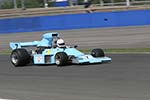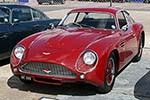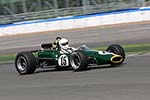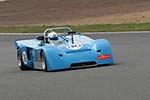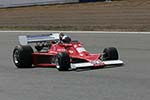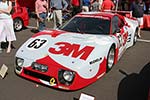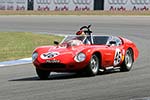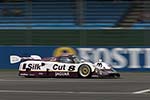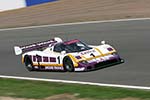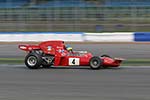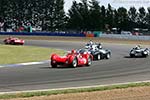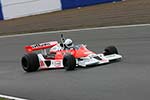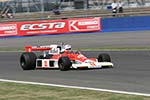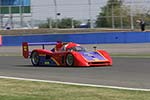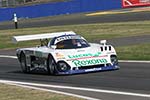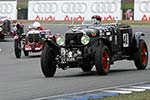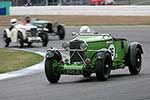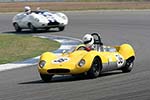Introduction

In 2005 a great tradition was reinstated with the first Silverstone Classic meeting. Historic racing and the home of the British Grand Prix had gone very well together in the past, but for various reasons the annual Historic Festival was abandoned after 2001. The success of last year�s �Classic� did not come as a surprise and this year�s edition was looked forward to by historic racers and fans alike.
With single seaters and sports cars from as early as the 1920s and as late as the 1990s on track, the 2006 Silverstone Classic was a very exciting, noisy and smelly motor racing history lesson. If the over 600 cars on track were not enough to please the gathered enthusiasts, the vast infield area hosted a large number of clubs and demonstrations of various kinds. Aston Martin�s racing efforts took centre stage this weekend with a one make race and a pursuit between a number of classic and modern racers. A rundown of the weekend�s highlights can be found in the following paragraphs and a pictorial impression in an exclusive
200-shot slideshow, separately depicting every class.
Aston Martin
While there was no real theme to last year�s event, the 2006 Classic was clearly centered on Aston Martin. The company�s racing successes of the 1930s and 1950s were celebrated with the Roy Salvadori Trophy of Aston Martin Cars. The three DBR1s, including the 1959 Le Mans first and second placed cars, were the highlights of the highly varied field. A slight oddball in the group was the Lagonda V12 present, which was one of only two cars briefly campaigned by the Aston Martin/Lagonda works team. Further entertainment was provided by Aston Martin Racing, who brought a DBRS9 and a DBR9, and David Brabham and Prodrive supremo David Richards to drive the two GT-racers in a pursuit. The modern machines were pitched against the Le Mans winning DBR1 and a DB4 GT, which were given a head start. On Saturday, the experienced drivers of the old machines took the race a little too serious and made David Brabham�s life in the DBRS9 very difficult. At the second attempt on Sunday followed the plan a little better with all four cars crossing the line in close proximity of each other. In the warm up lap the four racers were joined by a DBR2, which was only very recently acquired by its new owner from the United States. Not being in racing condition, the car was able to take on its peers in Roy Salvadori Trophy, but the new owner did not want to miss out on the opportunity to showcase the car for the firs time in its home country for many, many years. On Saturday the pilot on duty was former Grand Prix driver Richard Attwood and on Sunday ace historic racer Gary Pearson was handed the keys. A little too young to take on its 1930s and 1950s stable mates, there was another Aston that took to the track; the AMR1 in the Group C / GTP races. After setting a very fast time on Friday, the blue, white and red coupe was forced to retire from the first of two races with technical problems that could not be solved on the track.
Next year the featured marque will be Porsche.
Star drivers
In the report of last year�s race we highlighted three drivers, which starred throughout the weekend. This year two of them were absent and the other, Martin Stretton, had a pretty terrible weekend. It already started off wrong when he crashed into the back of a slower car in his March 712. After being airborne for a few meters he smacked back to the ground, damaging the tub of his car in the progress. So despite setting the fastest lap, he could not take up his pole position. Co-driving Jose Alberquerque�s Chevron B16 and Maserati 300 S throughout the weekend he was still able to showcase his exciting style, but for a change he did manage to rack up a victory. He was very close in the Chevron, until engine problems saw him drop down the field and eventually retire with less than five minutes to go.
Fellow sideways expert Barrie Williams also had a weekend he�d rather forget about quickly. He was doing a very fast job in Burkhard von Schenk�s Cooper Maserati, which ended suddenly after he rolled in bridge bend. He finished upside down in what looked like a very uncomfortable position. Fortunately once the car was turned back on his wheels was able to walk away; shaken, but not stirred. It was even more remarkable to see both �Whizzo� and the Cooper back in action later in the weekend. In another heart stopping accident, Gary Pearson was forced to jump out of his AC Cobra. After a run in with another car, the fuel pipe had come loose and quickly turned the car into a ball of fire. Fortunately this also turned out to be not as bad as it looked at first; roasted, but not burned to the ground.
Simon Hadfield on the other hand had a much better time, scoring three wins and a second place with some very varied machines. With Stretton�s March out of contention, there was no real opposition in the Derek Bell Trophy races, where he reigned supreme in his rather ugly Lola T300 F5000 racer. It was not as straightforward in the Duncan Hamilton Trophy where he fought of strong opposition in his Cooper Monaco. Again benefiting from Stretton�s misfortunes Hadfield was able to convert a very strong drive to a second place finish, together with Michael Schryver in the latter�s Chevron B6.
There was a very surprising winner in the second Grand Prix Masters race; Count Manfredo Rossi of Martini & Rossi fame. He beat the strong opposition in the Brabham BT42 owned by the family for over three decades. While his father backed many racing teams, he did not want his son to go racing. Only after his father passed away, three years ago, did he venture into motorsport. Much to his own surprise, he was able to beat seasoned Historic Formula 1 racer Peter Wuensch in his more modern Wolf.
Star cars
With the amazing fields of the Le Mans Classic and Monaco Historic Grand Prix already behind us, we were once again surprised by some exceptionally rare machinery. While going through the entry lists before the events, we were really grabbed by the Brabham BT24 and Mazda 757, both because of their rare engines. The Brabham was one of the very first 3-litre Formula 1 cars, powered by a Repco V8; this was the first time we had ever seen a Repco engined car in action. Even more special was the rotary engined Mazda, which produced one of the best notes we ever heard. Even though both racers predominantly ran at the back of their respective fields, it�s cars like these that make these trips really worth it.
Conclusion
Packed fields, close racing and big names; it is hardly a surprise that close to 40,000 enthusiasts flocked to Silverstone for the Classic. We are confident few were disappointed by either the offered program or the non-British comfortable weather. The grandstands for the last race of the weekend were still well packed and the patient crowd was treated to spectacular slides produced by the historic touring cars. In return the drivers were enthusiastically applauded for their efforts. This was typical for the pleasant atmosphere on and around the track. The only downside of the large number of fields is that some cars were only on track on Friday and Saturday and some even only on Friday, or it is a good reason to go all three days. For the historic racing enthusiast, it will be hard to justify skipping the 2007 Silverstone Classic!

| |
|
| |
|
|
|
|
| |
|
|
|
|
| |
|
|
|
|
| |
|
|
|

|
|
|
BRM P160
|
35

|
| Years of production: |
1971 - 1973 |
| Last updated: |
12 / 06 / 2011 |
|
|
| |
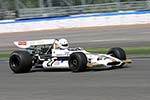
|
|
|
BRM P153
|
36

|
| Produced in: |
1970 |
| Last updated: |
03 / 20 / 2007 |
|
|
|

|
|
|
BRM P126
|
31

|
| Years of production: |
1968 - 1969 |
| Last updated: |
04 / 10 / 2015 |
|
|
| |
|
|
|
|
| |
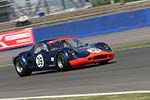
|
|
|
Chevron B8 BMW
|
210

|
| Years of production: |
1968 - 1970 |
| Last updated: |
12 / 14 / 2009 |
|
|
|
|
| |
|
|
|
|
| |
|
|
|
|
| |
|
|
|
|
| |
|
|
|
|
| |
|
|
|
|
| |
|
|
|
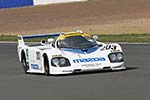
|
|
|
Mazda 757
|
36

|
| Years of production: |
1986 - 1987 |
| Last updated: |
06 / 22 / 2015 |
|
|
| |
|
|
|
|
| |
|
|
|
|
| |
|
|
|
|
| |
|
|
|
|
| |

 In 2005 a great tradition was reinstated with the first Silverstone Classic meeting. Historic racing and the home of the British Grand Prix had gone very well together in the past, but for various reasons the annual Historic Festival was abandoned after 2001. The success of last year�s �Classic� did not come as a surprise and this year�s edition was looked forward to by historic racers and fans alike.
In 2005 a great tradition was reinstated with the first Silverstone Classic meeting. Historic racing and the home of the British Grand Prix had gone very well together in the past, but for various reasons the annual Historic Festival was abandoned after 2001. The success of last year�s �Classic� did not come as a surprise and this year�s edition was looked forward to by historic racers and fans alike.


